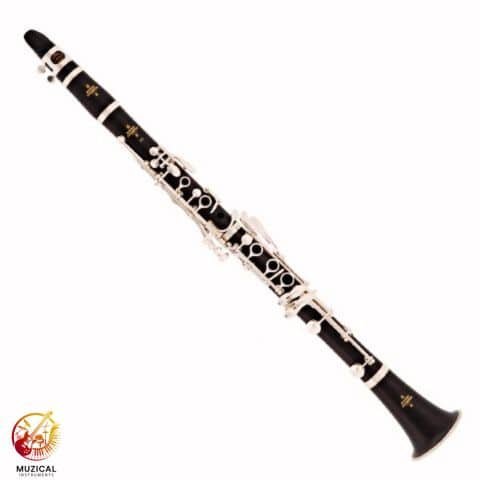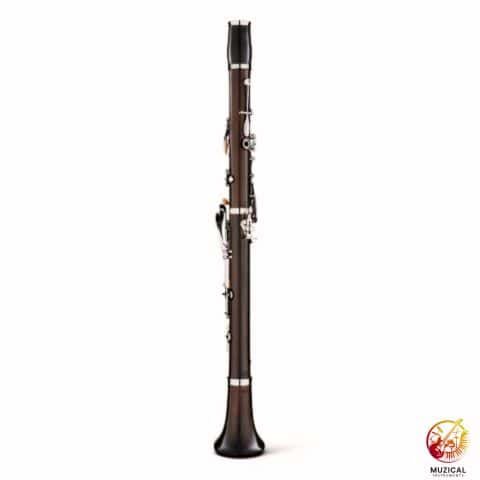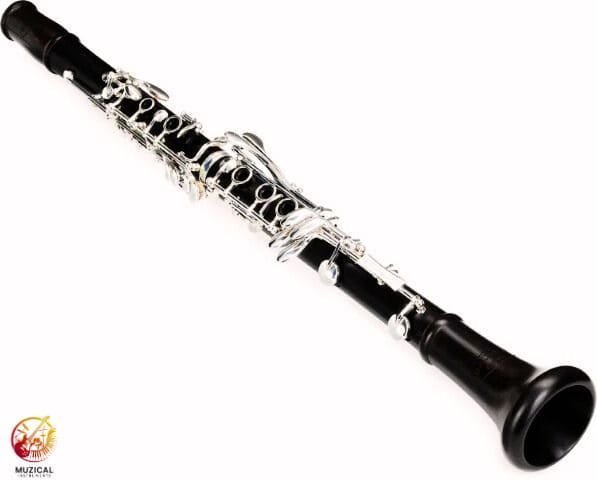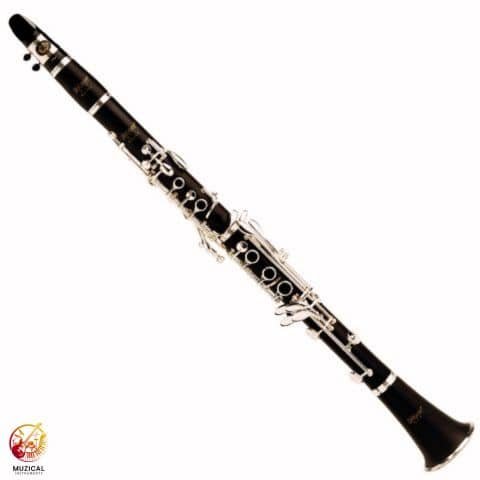Best Clarinet for Intermediate Players
Affiliate Disclosure
This post may contain affiliate links. If you buy through them, I may earn a small commission at no extra cost to you. This helps support the site and keeps our content free for you.
If you prefer not to use affiliate links, you can search products directly on the maker’s site.
It’s exciting when you’ve outgrown your first clarinet. Now you need an instrument that matches your skill. But finding the best clarinet for intermediate players feels isn’t easy. There are so many brands and features to compare.
This guide is here to help you sort it all out. You will learn what makes one clarinet better than another. We’ll help you find an instrument you’ll love to play.
Our Recommendations: Best Clarinet for Intermediate Players
| Brand & Model | Image | Material | Key Features | Check Current Price |
|---|---|---|---|---|
| Yamaha YCL-450 |

| Grenadilla Wood | Adjustable thumb rest, solid tone | Check Price |
| Buffet Crampon E11 |

| Grenadilla Wood | French bore, bright tone | Check Price |
| Backun Alpha |

| Synthetic | Durable body, Lightweight design | Check Price |
| Backun Protege |

| Wood | Custom barrels, smooth response | Check Price |
| Selmer CL211 |

| Grenadilla Wood | Ergonomic keys, warm sound | Check Price |
What Makes a Clarinet Good for Intermediate Players?
When you’re at the intermediate level, your needs shift. Beginner clarinets are built for durability and ease. But now, you’re chasing tone, response, and control. That means your next clarinet for intermediate players must support that growth.
The first thing to look at is material. Most beginner clarinets are plastic (ABS resin). But intermediate ones often use grenadilla wood. This gives your tone more depth. Wood responds better to breath control and embouchure changes.
Next is the key mechanism. Intermediate clarinets usually come with silver–plated or nickel–plated keys. Silver feels smoother and resists tarnish better but costs more. Also, you’ll see features like an adjustable thumb rest and undercut tone holes. These tiny changes help a lot with comfort and intonation.
The bore size also changes. Intermediate models may have a slightly larger bore, which gives more freedom in tone shaping. But this also means you need better breath support and embouchure control.
Finally, intermediate clarinets are built with better pads, springs, and overall finishing. That means fewer leaks and better sealing, which gives you a cleaner, more stable sound.
Expert Insight:
A music teacher once told me, “If your clarinet makes you work too hard, it’s not the right one.” The right intermediate clarinet should help you grow, not hold you back.
Which Brands Offer the Best Clarinet for Intermediate Players?
There are a few brands that dominate the space for good reason. Yamaha, Buffet Crampon, Backun, and Selmer are the most trusted names when searching for a clarinet for intermediate players. Each has models that fit different playing styles and budgets.
Yamaha YCL-450: A Reliable Choice for Intermediate Players

Yamaha YCL-450
- Warm, resonant tone from grenadilla wood, close to professional sound
- Smooth, balanced keywork for easier control in fast passages
- Durable for daily use yet refined for ensembles or solo playing
The Yamaha YCL-450 is one of the most trusted clarinets for players stepping beyond the beginner stage. Built from grenadilla wood, it offers a warm, resonant tone that feels close to professional models. The keywork is smooth and well-balanced, making fast passages easier to control. Yamaha designed this model with a slightly more resistant blow, which helps you develop proper embouchure strength and tone consistency. It’s also durable enough for daily practice and school performances, yet refined enough for small ensemble or solo playing.
Buffet Crampon E11: A Classic Step-Up Clarinet
Buffet Crampon E11
- Warm, expressive tone from African blackwood, ideal for ensembles and solos
- Precise French craftsmanship with balanced intonation across registers
- Bridges the gap between student and professional models
The Buffet Crampon E11 is one of the most popular choices for advancing clarinetists who are ready to leave their student instrument behind. Made from African blackwood (grenadilla), it produces a warm, expressive tone that blends beautifully in ensembles yet stands out in solo passages. The craftsmanship reflects Buffet’s French tradition, with precise keywork and balanced intonation across registers. The E11 is designed to help you refine your control, especially in the chalumeau and clarion registers, where clarity and projection are essential. Many teachers recommend it because it bridges the gap between student and professional models without overwhelming the player.
Backun Alpha: A Smart Choice for the Advancing Player
Backun Alpha
- Clear, focused tone with stable intonation across registers
- Durable synthetic body resistant to weather and humidity
- Lightweight design with smooth, ergonomic keywork
The Backun Alpha is a standout option for intermediate clarinetists who want professional-level features without the price of a wooden model. Made from a high-quality synthetic material, it delivers a clear, focused tone that rivals wood while being more resistant to temperature and humidity changes. The design includes precision keywork and an ergonomic feel that makes fast technical passages smoother and more comfortable. What sets the Alpha apart is its consistency, intonation is stable across registers, making it reliable for both practice and performance. It’s also lighter than many wooden clarinets, which is a plus for younger or smaller players. Overall, it’s an excellent step-up instrument for students who want performance and durability in one package.
Backun Protégé: Professional Sound for the Advancing Player
Backun Protégé
- Warm, resonant grenadilla wood tone with strong projection
- Smooth, responsive keywork for precise control
- Free-blowing design supports full dynamic range
The Backun Protégé is a remarkable clarinet designed for serious intermediate players who want to step closer to a professional instrument. Crafted from premium grenadilla wood, it offers a warm, resonant tone with excellent projection, making it suitable for both solo and ensemble settings. The keywork is smooth and highly responsive, allowing precise control even in fast passages. One of its biggest strengths is its free-blowing design, which makes it easier for advancing players to explore a full dynamic range without losing tonal quality. The Protégé feels refined and balanced in the hands, giving you the confidence to grow technically and musically. It’s an investment, but one that bridges the gap beautifully between student and professional models.
Selmer CL211: Precision and Warmth for Growing Players
Selmer CL211
- Full, rounded grenadilla wood tone with excellent blend and clarity
- Smaller bore improves control and intonation for advancing players
- Smooth, comfortable keywork with strong projection for ensembles and solos
The Selmer CL211 is an excellent choice for intermediate clarinetists who want a balance of warmth, precision, and durability. Crafted from grenadilla wood, it produces a full, rounded tone that blends beautifully in ensembles but still has the clarity needed for solo work. Selmer designed this model with a slightly smaller bore, which gives players better control over intonation and response, especially helpful when transitioning from a student clarinet. The keywork is smooth and well-positioned, making it comfortable for longer practice or performance sessions. The CL211 also projects well without sacrificing tonal depth, making it a reliable choice for school bands, orchestras, and chamber music. It sits at a premium level within the intermediate range, appealing to players who want an instrument that will support them for years.
Should You Choose Wood or Plastic for Your Intermediate Clarinet?
You might think wood is always better. And it usually is if you’re ready for the maintenance. Grenadilla wood gives a warmer, richer tone. But it’s also sensitive to temperature and moisture.
Plastic clarinets, especially high-end ones like the Backun Alpha, are more stable in rough conditions. If you’re playing in a marching band or live in a humid place, plastic can make more sense. It’s also lower maintenance.
Here’s a quick comparison:
| Feature | Wood Clarinet | Plastic Clarinet |
|---|---|---|
| Sound Quality | Rich, warm, resonant | Bright, slightly thinner |
| Durability | Can crack with changes | Tough in all conditions |
| Weight | Slightly heavier | Lighter |
| Maintenance | Needs regular care | Low maintenance |
| Best For | Concert, classical use | Marching, school bands |
Some intermediate players buy both. A wood one for performances and a plastic one for rehearsals and outdoor gigs.
Expert Insight:
One advanced student I interviewed said, “My wood clarinet sings, but my plastic one survives.” That’s a smart way to think about it.
How Can You Tell If a Clarinet Fits Your Playing Style?
Every clarinet has its own “feel.” Some respond quickly but have a brighter tone. Others sound warm but require more breath control. Here’s what to consider:
- Tone preference: Do you like dark and mellow? Or bright and piercing?
- Resistance: A more open bore needs more air. A tighter bore may feel easier but limit tone shape.
- Key action: Are your fingers small or large? Try the key spacing.
Try out passages you often play scales, solos, and band pieces. Pay attention to how easily the notes respond. Do high notes pop out cleanly? Is the low register rich?
Also test intonation. Play long tones and check with a tuner. Some clarinets have sharp upper registers or flat throat tones.
Expert Insight:
Think of it like shoes. A clarinet might look great, but if it doesn’t feel right, you’ll regret the choice every time you practice.
How Do You Know When You’re Ready to Upgrade?
This is a question every clarinetist asks eventually. How do you know you’ve outgrown your student clarinet and are ready for a clarinet for intermediate players?
Here are some clear signs:
- Your tone feels limited or dull
- You’re struggling with fast finger passages
- You can’t project well in ensemble settings
- Teachers or directors are recommending an upgrade
Remember, an upgrade isn’t just about sound. It’s about playability. Intermediate clarinets respond faster. They help you control dynamics better. If your current clarinet is holding you back, it’s time.
Quick Self-Check:
Try playing a chromatic scale from low E to high C. If the response feels uneven or the tone doesn’t hold across registers, you’re ready.
What Accessories Should You Pair With an Intermediate Clarinet?
The clarinet for intermediate players is just the start. To really make it shine, you’ll want to pair it with better accessories too.
Mouthpiece: Most stock mouthpieces on intermediate models are just okay. Consider upgrading to a Vandoren M13 or B45. These give you better control and sound color.
Ligature: A Rovner or Vandoren Optimum ligature holds the reed evenly and boosts your tone.
Reeds: Stick to quality reeds like Vandoren Traditional (Blue Box) or D’Addario Reserve. You may need to experiment with strengths between 2.5 and 3.5 to find your match.
Swab and Cork Grease: Basic but essential. You’ll want to keep the bore clean and the joints smooth.
Expert Tip: The mouthpiece and reed combo impacts your sound as much as the clarinet itself. Don’t skimp here.
Final Thoughts: What’s the Best Clarinet for Intermediate Players?
The best clarinet for intermediate players isn’t a one-size answer. It depends on where you play, how serious you are, and what sound you want.
Start by picking a trusted brand like Yamaha, Buffet, or Backun. Decide if you want wood or plastic based on tone and environment. Set your budget, and play-test models if you can.
Once you find one that fits your hand, your breath, and your ears, it becomes more than a tool. It becomes your voice.
So don’t rush. Try a few. Ask questions. And trust your ear. Because the right clarinet doesn’t just play better. It makes you better.
Now go find your sound.
Before choosing your next clarinet, check out this German vs French clarinet comparison to see which system might suit your playing style better.
FAQs: Best Clarinet for Intermediate Players
Q1: Is it worth upgrading to a wooden clarinet as an intermediate player?
Yes, if you’re serious about tone. Wooden clarinets offer richer, warmer sounds and respond better to breath and embouchure changes. But they require more care.
Q2: Can an intermediate clarinet last me into advanced levels?
Absolutely. Many models like the Yamaha YCL-450 or Buffet E11 are used well into advanced levels. With proper care, they can last years.
Q3: Should I buy a used clarinet?
It depends. If the clarinet is in good condition and has been serviced, a used one can save money. But always test it first or have a teacher evaluate it.
Q4: What accessories should I upgrade with my intermediate clarinet?
Consider a better mouthpiece, ligature, and swab. These can noticeably improve sound and comfort without changing the clarinet itself.
Q5: How do I know if my clarinet needs to be replaced or just repaired?
If you’re struggling with tone or tuning, get it checked first. Pad leaks and alignment issues are common. But if repairs cost more than half the clarinet’s value, an upgrade makes more sense.
